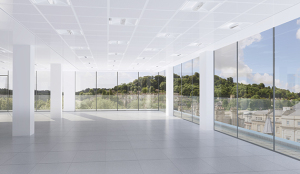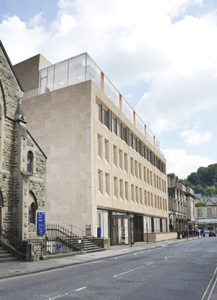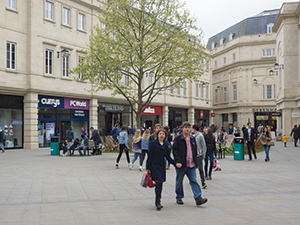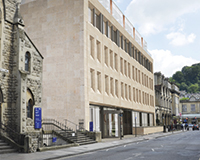 Proof, if it were needed, of Bath’s tourist appeal can be found in one striking statistic in Carter Jonas’s latest Commercial Edge report – that in 2013 the Roman Baths attracted 1.2m visitors, which is more than either the Eden Project or the Houses of Parliament.
Proof, if it were needed, of Bath’s tourist appeal can be found in one striking statistic in Carter Jonas’s latest Commercial Edge report – that in 2013 the Roman Baths attracted 1.2m visitors, which is more than either the Eden Project or the Houses of Parliament.
For the city, however, that is something of a double-edged sword, as the local authority recognises. John Wilkinson, divisional director for community regeneration at Bath & North East Somerset council, says that in terms of productivity levels, the city performs less well than regional and national averages, and that is because of an over-reliance on service industries such as tourism and retail, which are less well paid.
The council’s strategy for the local economy is, therefore, predicated on raising those wage levels and broadening its approach to embrace sectors including digital technology, environment and energy.
The potential gain for the city is enormous, with the West of England LEP’s strategic economic plan for 2015 to 2030 forecasting a £400m GVA uplift derived from the creation of a £1bn Bath City Riverside Enterprise Area, a key plank of the local authority’s plans and an area that could become a major hub for creative and ICT companies.
At present, a major stumbling block for Bath lies in its profound lack of modern, grade-A office accommodation. Wilkinson describes the shortage as a “key blockage” and adds: “We know there is strong demand from these sectors, but we don’t have the modern space to attract them.”
A combination of factors has led to the lack of core employment space – the legacy of an historic moratorium on new development and a more recent trend of office-to-residential conversions among them. Office take-up in the city has, consequently, been severely restricted in the first half of 2015, plummeting from around 90,000 sq ft in 2014 to just 20,000 sq ft in the first half of this year.
Simon Price, partner at Alder King’s Bristol office, cites a serious implication – a widening rental gap. Bath and Bristol rents were previously on a par, but Bath’s headline figures are now just £21 per sq ft while Bristol is pushing £30. There is also growing frustration among occupiers, who cannot find modern, flexible space.
“The biggest risk to the city is that occupiers who are looking to expand cannot find the space and are relocating elsewhere, particularly to Bristol,” says Price. “As a result, Bath becomes even more focused on tourism and retail, while what it needs is a mixed economy.”
Verve Properties, the company behind Bristol’s successful Paintworks scheme, spent a lot of time trying to create a similar model for creative industries in Bath, but without success. The firm’s Ashley Nicholson believes demand is strong, but Bath is a tight market.
It is well documented that Future Publishing, which employs hundreds of people in Bath, has investigated alternative locations in the past.
“It hasn’t happened yet but, inevitably, if Bath doesn’t bring forward new grade-A space, it will lose a major employer,” Richard Kidd, director at Bilfinger GVA, warns.
A handful of existing or potential occupiers have already been enticed by the greater choice of property offered by Bristol, among them Creston, Civica, Semperian, Purple Secure and Parmenion Capital – which, between them, represent the marketing, IT and investment sectors.
Parmenion Capital wanted to swap serviced offices in Bath’s Tramshed for up to 5,000 sq ft. However a year long search for open plan offices proved fruitless.
David Tanner, head of operations, says Bristol, providing it with access to more services and easier staff recruitment therefore became it’s first choice.
It is against the backdrop of these challenges that the local authority is prioritising the creation of a new office quarter, using two council-owned sites within the Enterprise Area called South Quays and North Quays. The council’s Wilkinson says: “We hope we are sending out a strong signal to the market. It has taken a lot of time and money to work up these schemes and next January the diggers will roll in.”
Designation of the Enterprise Area, which takes in large parts of the waterfront, is giving the council greater retention of its business rates. Income from that ‘pot’ is helping to fund two key pieces of infrastructure that will enable the new employment areas to come forward – flood protection works, which start at the beginning of 2016, and a new river bridge crossing.
Meanwhile, Wilkinson says the council is working closely with Lambert Smith Hampton to establish what kind of space the market is looking for at North Quays, where plans for 220,000 sq ft could go for outline permission next year.
 At South Quays, the council is in talks with local employer BMT for it to take a 50,000 sq ft headquarters, a scheme that will also provide 30-40,000 sq ft of flexible, smaller workspace units. An application is expected in early 2016. The council is exploring various development options for both schemes including a potential jv partnership. .
At South Quays, the council is in talks with local employer BMT for it to take a 50,000 sq ft headquarters, a scheme that will also provide 30-40,000 sq ft of flexible, smaller workspace units. An application is expected in early 2016. The council is exploring various development options for both schemes including a potential jv partnership. .
In the meantime, one scheme that is getting off the ground is a refurbishment of 20 Manvers Street (pictured), which will see 45,000 sq ft of modern space, including a new top floor created in the West Midlands Pension Fund-owned city centre building. A year-long redevelopment programme is expected to get under way in October. The developer isn’t quoting rents yet but those that know the market well say the scheme has potential to achieve in excess of £20 per sq ft.
Local planners have been very supportive of the scheme, according to Knight Frank partner Martin Booth, who is marketing it. Bearing in mind Bath’s infamous lack of modern space, he is certain the council will “breathe a sigh of relief when we pick up the phone and say we are starting on site”.
Retail strengths
Compared with its struggling office market, the strength of Bath’s retail and leisure sector continues unabated but, strangely, the two are united by one factor – a space problem.
 Mike McElhinney, partner with Carter Jonas, says two large parts of the city centre have been taken out – a chunk of space in Stall Street leased to Holland & Barrett and The Octagon, an 8,000 sq ft upper level of Milsom Place, which has been leased to restaurant chain Burger & Lobster. “This means that, suddenly, for a long time there is no big space available in the city centre,” he says.
Mike McElhinney, partner with Carter Jonas, says two large parts of the city centre have been taken out – a chunk of space in Stall Street leased to Holland & Barrett and The Octagon, an 8,000 sq ft upper level of Milsom Place, which has been leased to restaurant chain Burger & Lobster. “This means that, suddenly, for a long time there is no big space available in the city centre,” he says.
Stuart Parsons, divisional director at Fleurets, says Pitcher & Piano and Revolution are among those looking for large spaces, which are hard to find.
But despite the challenge, demand remains strong. Chris Thomas, senior director at CBRE, identifies 30 new retail entrants since early 2014 and about 16 new restaurant/café operators.
Newcomers include Australian tea business T2, and Italian make-up retailer Kiko Milano, which has just opened at SouthGate shopping centre (pictured). Thai Giggling Squid plans new space near the city’s theatre and, at Milsom Place, steakhouse Cau will add to the offering.
Matt Taylor, associate at MMX, says Milsom Place – recently purchased by TH Real Estate – wants to take a “best in class” approach.











